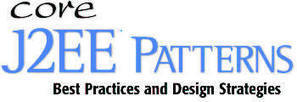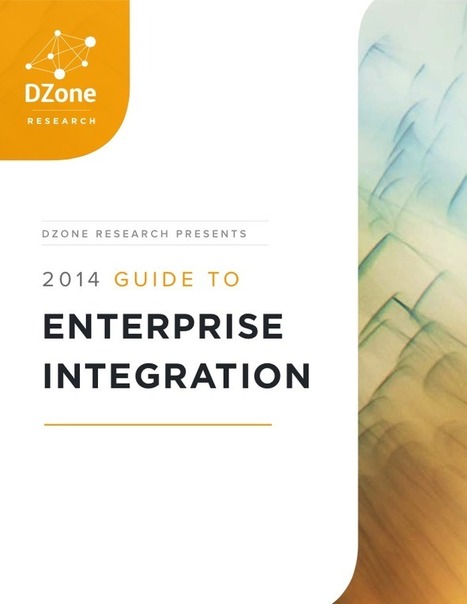 Your new post is loading...
 Your new post is loading...

|
Scooped by
Mickael Ruau
March 24, 2015 10:24 AM
|
able of Contents
1. Annotations in Java
1.1. Annotations in Java
1.2. Standard annotations in Java
1.3. Type annotations
2. Defining custom annotations
2.1. Define your custom annotation
2.2. Accessing your annotation via Java reflection
3. Repeatable annotations in Java 8
4. Exercise: Define and analyze your own annotation
5. About this website
5.1. Donate to support free tutorials
5.2. Questions and discussion
5.3. License for this tutorial and its code
6. Links and Literature
6.1. Source Code
6.2. General

|
Scooped by
Mickael Ruau
March 7, 2015 11:56 AM
|
Download DCP Setup Maker. Powerful cross-platform install builder

|
Scooped by
Mickael Ruau
February 26, 2015 2:12 AM
|
DevNexus 2014 Hibernate has always revolved around data, ORM, and JPA. However, it’s much more than that. Hibernate has grown into a family of projects and c…

|
Scooped by
Mickael Ruau
February 25, 2015 3:57 AM
|
Ce site a été créé par des consultants en technologies objet, spécialistes de java. Le but principal est de recueillir les informations techniques rassemblées au cours de leurs missions, sous forme de bloc-note.

|
Scooped by
Mickael Ruau
February 25, 2015 2:41 AM
|
Hibernate ORM & JPA Overview Brett Meyer Senior Software Engineer Hibernate ORM, Red Hat

|
Scooped by
Mickael Ruau
February 23, 2015 1:41 AM
|
In this chapter from Core Java for the Impatient, you will learn about interfaces and lambda expressions, including static and default methods, method and constructor references, processing lambda expressions, variable scope, higher-order functions, and local inner classes.

|
Scooped by
Mickael Ruau
February 17, 2015 2:40 AM
|
Albert Guo [email_address]

|
Scooped by
Mickael Ruau
February 15, 2015 11:14 AM
|
Bien que les enums soient apparues en java 5, elles restent relativement méconnues. Voyons donc quelques patterns d'implémentation. On commence par quelques points techniques

|
Scooped by
Mickael Ruau
February 11, 2015 5:53 PM
|
Voilà bien un sujet sur lequel j’ai adopté (une fois encore) la position du sceptique. Quand on m’a exposé l’idée de l’inversion de contrôle, j’ai trouvé que c’était un point de vue intéressant mais sans plus. Quand j’ai commencé à voir les premiers fichiers de configuration Spring en XML, j’ai écarquillé les yeux… Constater qu’une partie de mon code Java, organisé, compilé et déboguable, devait se retrouver sous forme déstructurée dans du XML peu lisible et mal contrôlé, ne m’a simplement pas emballé. Ce constat n’a pas empêché une flopée de développeurs de faire du Spring à fond les manettes, persuadés d’adhérer à une innovation majeure, avec parfois une pointe de dédain envers ceux qui n’en faisaient pas !

|
Scooped by
Mickael Ruau
February 11, 2015 5:46 PM
|
Of the SOLID principles, made famous by Robert C. Martin, we'll discuss the Single Responsibility Principle and the Open/Closed Principle, two of the presenter's favorite principles. But at the same time the least understood and used principles. That's why this session will explain them thoroughly and give real life examples instead of the regular customer & order examples. You'll walk away knowing what the benefits are and how to use them properly.

|
Scooped by
Mickael Ruau
February 11, 2015 5:32 PM
|
The following article aims to explain the five SOLID principles with real world examples. The SOLID principles are five programming principles which is considered to be the foundation of every well designed application. Following the principles will most likely lead to applications which are is easy to extend and maintain. That’s possible since you got small well defined classes with clear contracts.

|
Scooped by
Mickael Ruau
February 11, 2015 5:29 PM
|

|
Scooped by
Mickael Ruau
February 11, 2015 5:20 PM
|
The first five principles are principles of class design. They are:
SRP The Single Responsibility Principle A class should have one, and only one, reason to change.
OCP The Open Closed Principle You should be able to extend a classes behavior, without modifying it.
LSP The Liskov Substitution Principle Derived classes must be substitutable for their base classes.
ISP The Interface Segregation Principle Make fine grained interfaces that are client specific.
DIP The Dependency Inversion Principle Depend on abstractions, not on concretions.
The next six principles are about packages. In this context a package is a binary deliverable like a .jar file, or a dll as opposed to a namespace like a java package or a C++ namespace.
The first three package principles are about package cohesion, they tell us what to put inside packages:
REP The Release Reuse Equivalency Principle The granule of reuse is the granule of release.
CCP The Common Closure Principle Classes that change together are packaged together.
CRP The Common Reuse Principle Classes that are used together are packaged together.
The last three principles are about the couplings between packages, and talk about metrics that evaluate the package structure of a system.
ADP The Acyclic Dependencies Principle The dependency graph of packages must have no cycles.
SDP The Stable Dependencies Principle Depend in the direction of stability.
SAP The Stable Abstractions Principle Abstractness increases with stability.
|

|
Scooped by
Mickael Ruau
March 24, 2015 10:24 AM
|
Table of Contents
1. Java Serialization
2. Example
3. About this website
3.1. Donate to support free tutorials
3.2. Questions and discussion
3.3. License for this tutorial and its code
4. Links and Literature

|
Scooped by
Mickael Ruau
February 27, 2015 2:41 AM
|
List of Topics What is Hibernate JDBC, ORM Hibernate Architecture Configuration Session Mapping Annotations HQL Caching Batch processing …

|
Scooped by
Mickael Ruau
February 25, 2015 4:01 AM
|
This website provides a palette of patterns you can use in the context of designing Java 2 Platform, Enteprise Edition (J2EE) applications. Occasionally, new patterns will be added and new insights will be incorporated into the current patterns, so check back often for updates. The BluePrints patterns catalog is based around the Sun Java Center patterns catalog, described in the Core J2EE Patternsbook by Deepak Alur, John Crupi, and Dan Malks.

|
Scooped by
Mickael Ruau
February 25, 2015 3:30 AM
|
Click on any pattern name to view the pattern in detail. Click here for printable view.

|
Scooped by
Mickael Ruau
February 23, 2015 3:42 PM
|
“Central”, “Maven Central”, “The Central Repository”. Vous rencontrez fréquemment ces termes dans le monde du développement Java open source. La plupart des collaborateurs de Sonatype pensent que tout le monde sait de quoi on parle lorsque l’on évoque « Central ». Comme ce n’est pas toujours le cas, cette vidéo vous donnera un aperçu de Central et ce qu’il représente pour la communauté Java. Bon visionnage !

|
Scooped by
Mickael Ruau
February 20, 2015 2:37 AM
|
Presentation from JEEConf conference (Kiev, May 2012) about issues in Hibernate usage and tricks to avoid them.

|
Scooped by
Mickael Ruau
February 16, 2015 5:17 PM
|
L'injection de dépendances est souvent la base de tout programme moderne. L'idée en résumé est de déporter la responsabilité de la liaison des composants du programme dans un framework afin de pouvoir facilement changer ces composants ou leur comportement. Parmi les leaders du marché Java, il y a Spring IoC, Guice, Dagger… ou encore le standard « Java EE » CDI qui existe depuis Java EE 6. Ce dernier s'est inspiré de plusieurs standards de facto, pour finalement devenir aujourd'hui la base de la plateforme Java EE moderne. Ce tutoriel vous propose un tour d'horizon des fonctionnalités de base de CDI.

|
Scooped by
Mickael Ruau
February 14, 2015 11:09 AM
|
Introduction to JPA and Hibernate including examples
ecosio GmbH
2,244 views

|
Scooped by
Mickael Ruau
February 11, 2015 5:48 PM
|
I stumbled across Uncle Bob’s SOLID principles of OOD quite a few years ago. They serve as the foundation of knowledge for designing object-oriented software. In fact, if you analyze the GOF patterns, you’ll find that virtually all of them adhere to the class design principles. I felt strongly enough about these principles that I included them in Chapter 1 of JOUP.
When used judiciously, they serve as excellent guidance in designing object-oriented software. But it’s not the SOLID class design principles I want to talk about here, at least not exclusively. Instead, it’s their less famous brethren that are often lost in the discussion of the SOLID class design principles…the principles of package design that I want to discuss.

|
Scooped by
Mickael Ruau
February 11, 2015 5:36 PM
|
Most professional software developers understand the academic definitions of coupling, cohesion, and encapsulation. However, many developers do not understand how to achieve the benefits of low coupling, high cohesion and strong encapsulation, as outlined in this article. Fortunately, others have created stepping stones that lead to these goals,
resulting in software that is easier to read, easier to understand and easier to change. In this article series, I will define three of the primary object-oriented principles and show how to reach them through the five S.O.L.I.D. design principles.

|
Scooped by
Mickael Ruau
February 11, 2015 5:30 PM
|
String in Java is final, Immutable and very special class. Surprisingly String is not a data type in Java instead String is an Object backed by char array. Few reasons why String is final, immutable and special in Java

|
Scooped by
Mickael Ruau
February 11, 2015 5:25 PM
|
Emergent design can quickly degrade into un-maintainable hack & slash yuckness without a set of guiding principles to keep you in check. Fortunately, Robert Martin’s SOLID Principles are just what the doctor ordered for saving your app from an early demise.
|
 Your new post is loading...
Your new post is loading...
 Your new post is loading...
Your new post is loading...




















